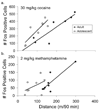Patterns of neural activity associated with differential acute locomotor stimulation to cocaine and methamphetamine in adolescent versus adult male C57BL/6J mice
- PMID: 19932887
- PMCID: PMC2814970
- DOI: 10.1016/j.neuroscience.2009.11.038
Patterns of neural activity associated with differential acute locomotor stimulation to cocaine and methamphetamine in adolescent versus adult male C57BL/6J mice
Abstract
Adolescence is a time period when major changes occur in the brain with long-term consequences for behavior. One ramification is altered responses to drugs of abuse, but the specific brain mechanisms and implications for mental health are poorly understood. Here, we used a mouse model in which adolescents display dramatically reduced sensitivity to the acute locomotor stimulating effects of cocaine and methamphetamine. The goal was to identify key brain regions or circuits involved in the differential behavior. Male adolescent (postnatal day (PN), 30-35) and young adult (PN, 69-74) C57BL/6J mice were administered an i.p. injection of cocaine (0, 15, 30 mg/kg) or methamphetamine (0, 2, 4 mg/kg) and euthanized 90 min later. Locomotor activity was monitored continuously in the home cage by video tracking. Immunohistochemical detection of Fos protein was used to quantify neuronal activation in 16 different brain regions. As expected, adolescents were less sensitive to the locomotor stimulating effects of cocaine and methamphetamine as indicated by a rightward shift in the dose response relationship. After a saline injection, adolescents showed similar levels of Fos as adults in all regions except the dorsal caudate (CPuD) and lateral caudate (CPuL) where levels were lower in adolescents. Cocaine and methamphetamine dose dependently increased Fos in all brain regions sampled in both adolescents and adults, but Fos levels were similar in both age groups for a majority of regions and doses. Locomotor activity was correlated with Fos in several brain areas within adolescent and adult groups, and adolescents had a significantly greater induction of Fos for a given amount of locomotor activity in key brain regions including the caudate where they showed reduced Fos under baseline conditions. Future research will identify the molecular and cellular events that are responsible for the differential psychostimulant-induced patterns of brain activation and behavior observed in adolescent versus adult mice.
Figures




Similar articles
-
Evaluation of a pharmacokinetic hypothesis for reduced locomotor stimulation from methamphetamine and cocaine in adolescent versus adult male C57BL/6J mice.Psychopharmacology (Berl). 2009 Jan;201(4):589-99. doi: 10.1007/s00213-008-1327-0. Epub 2008 Sep 17. Psychopharmacology (Berl). 2009. PMID: 18797848
-
Differential effects of methamphetamine and cocaine on conditioned place preference and locomotor activity in adult and adolescent male rats.Behav Brain Res. 2009 Mar 2;198(1):45-50. doi: 10.1016/j.bbr.2008.10.019. Epub 2008 Oct 18. Behav Brain Res. 2009. PMID: 18996417 Free PMC article.
-
Maturation of coordinated immediate early gene expression by cocaine during adolescence.Neuroscience. 2009 Apr 21;160(1):13-31. doi: 10.1016/j.neuroscience.2009.01.001. Epub 2009 Jan 7. Neuroscience. 2009. PMID: 19245875 Free PMC article.
-
Comparison of cocaine- and methamphetamine-evoked dopamine and glutamate overflow in somatodendritic and terminal field regions of the rat brain during acute, chronic, and early withdrawal conditions.Ann N Y Acad Sci. 2001 Jun;937:93-120. doi: 10.1111/j.1749-6632.2001.tb03560.x. Ann N Y Acad Sci. 2001. PMID: 11458542 Review.
-
The hidden side of drug action: brain temperature changes induced by neuroactive drugs.Psychopharmacology (Berl). 2013 Feb;225(4):765-80. doi: 10.1007/s00213-012-2957-9. Epub 2012 Dec 29. Psychopharmacology (Berl). 2013. PMID: 23274506 Free PMC article. Review.
Cited by
-
Age-dependent differences in the strength and persistence of psychostimulant-induced conditioned activity in rats: effects of a single environment-cocaine pairing.Behav Pharmacol. 2014 Oct;25(7):695-704. doi: 10.1097/FBP.0000000000000085. Behav Pharmacol. 2014. PMID: 25171082 Free PMC article.
-
Unusual effects of nicotine as a psychostimulant on ambulatory activity in mice.ISRN Pharmacol. 2012;2012:170981. doi: 10.5402/2012/170981. Epub 2012 Mar 20. ISRN Pharmacol. 2012. PMID: 22530136 Free PMC article.
-
Chronic D-amphetamine administered from childhood to adulthood dose-dependently increases the survival of new neurons in the hippocampus of male C57BL/6J mice.Neuroscience. 2013 Feb 12;231:125-35. doi: 10.1016/j.neuroscience.2012.11.028. Epub 2012 Nov 20. Neuroscience. 2013. PMID: 23178911 Free PMC article.
-
Brain regions and monoaminergic neurotransmitters that are involved in mouse ambulatory activity promoted by bupropion.Toxicol Rep. 2016 Jun 21;3:552-562. doi: 10.1016/j.toxrep.2016.06.005. eCollection 2016. Toxicol Rep. 2016. PMID: 28959579 Free PMC article.
-
Acute locomotor responses to cocaine in adolescents vs. adults from four divergent inbred mouse strains.Genes Brain Behav. 2010 Nov;9(8):892-8. doi: 10.1111/j.1601-183X.2010.00630.x. Genes Brain Behav. 2010. PMID: 20662938 Free PMC article.
References
-
- Andersen SL, LeBlanc CJ, Lyss PJ. Maturational increases in c-fos expression in the ascending dopamine systems. Synapse. 2001;41:345–350. - PubMed
-
- Atkins AL, Helms ML, O'Toole LA, Belknap JK. Stereotypic behaviors in mice selectively bred for high and low methamphetamine-induced stereotypic chewing. Psychopharmacology (Berl) 2001;157:96–104. - PubMed
-
- Azar MR, Acar N, Erwin VG, Barbato GF, Morse AC, Heist CL, Jones BC. Distribution and clearance of cocaine in brain is influenced by genetics. Pharmacol Biochem Behav. 1998;59:637–640. - PubMed
-
- Badiani A, Oates MM, Day HE, Watson SJ, Akil H, Robinson TE. Environmental modulation of amphetamine-induced c-fos expression in D1 versus D2 striatal neurons. Behav Brain Res. 1999;103:203–209. - PubMed
-
- Bolam JP, Izzo PN, Graybiel AM. Cellular substrate of the histochemically defined striosome/matrix system of the caudate nucleus: a combined Golgi and immunocytochemical study in cat and ferret. Neuroscience. 1988;24:853–875. - PubMed
Publication types
MeSH terms
Substances
Grants and funding
LinkOut - more resources
Full Text Sources
Other Literature Sources
Medical
Research Materials

